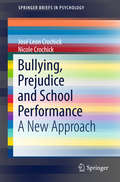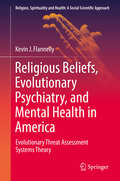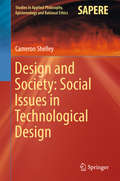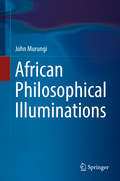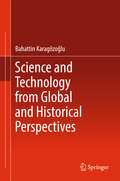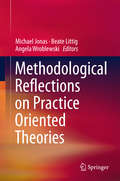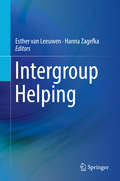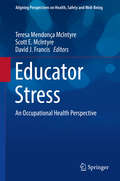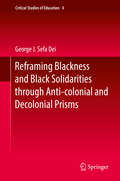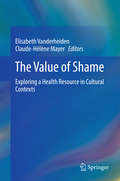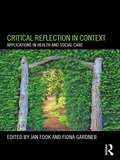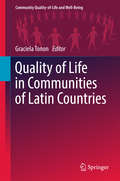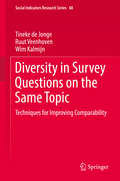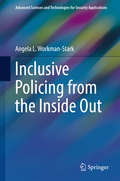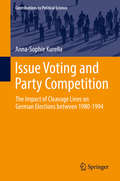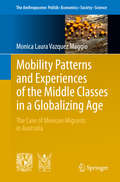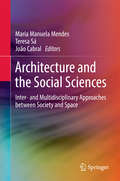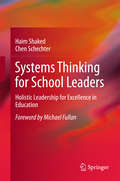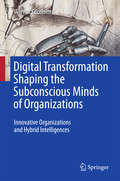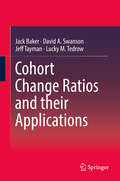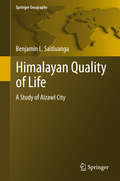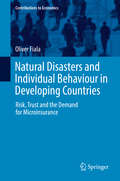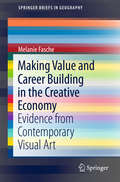- Table View
- List View
Bullying, Prejudice and School Performance: A New Approach (SpringerBriefs in Psychology)
by José Leon Crochick Nicole CrochickThis brief presents a new approach to the study of bullying and prejudice in school settings, analyzing the particularities of these two forms of violence and relating them to the hierarchies that distinguish students based on academic performance and popularity. Analyzing data gathered by surveys carried out between 2010 and 2014 with 274 students from public schools of São Paulo, Brazil, the authors show that, despite bullying and prejudice are related, they have specific characteristics that need to be acknowledged in order to help educators develop more efficient initiatives to prevent them. Building upon the Critical Theory of Society – especially Adorno’s studies of authoritarian personality and school hierarchies – the authors develop a theoretical framework that helps researchers and educators to identify the particularities of bullying and prejudice and develop specific strategies to deal with them. In addition, the empirical and theoretical elements presented in the book show how these forms of violence are related to the two hierarchies that exist side by side in schools – the official hierarchy that distinguishes good and bad students based on their academic performance and the unofficial hierarchy characterized by the distinction between those who excel in dating, fighting, in team sports and those who do not excel in any of these activities. This innovative volume:• Argues that bullying and prejudice are different forms of school violence that demand different theoretical and practical approaches• Examines data gathered by surveys carried out with 274 students of public schools in São Paulo, Brazil, between 2010 and 2014 • Relates bullying and prejudice to the hierarchies that distinguish students based both on their academic performance and popularity• Analyzes the impact of factors such as autonomy from the school authority and the ideology of authoritarianism on bullying and prejudice• Presents strategies to fight bullying and prejudice in schoolsBullying, Prejudice and School Performance: A New Approach is a useful and innovative tool for psychologists, educators, sociologists, school teachers and researchers in the fields of child and school psychology, educational psychology, sociology of education and related disciplines.
Religious Beliefs, Evolutionary Psychiatry, and Mental Health in America: Evolutionary Threat Assessment Systems Theory (Religion, Spirituality and Health: A Social Scientific Approach #1)
by Kevin J. FlannellyThis book provides a new perspective on the association between religious beliefs and mental health. The book is divided into five parts, the first of which traces the development of theories of organic evolution in the cultural and religious context before Charles Darwin. Part II describes the major evolutionary theories that Darwin proposed in his three books on evolution, and the religious, sociological, and scientific reactions to his theories. Part III introduces the reader to the concept of evolutionary psychiatry. It discusses how different regions of the brain evolved over time, and explains that certain brain regions evolved to protect us from danger by assessing threats of harm in the environment, including other humans. Specifically, this part describes: how psychiatric symptoms that are commonly experienced by normal individuals during their everyday lives are the product of brain mechanisms that evolved to protect us from harm; the prevalence rate of psychiatric symptoms in the U.S. general population; how religious and other beliefs influence the brain mechanisms that underlie psychiatric symptoms; and the brain regions that are involved in different psychiatric disorders. Part IV presents the findings of U.S. studies demonstrating that positive beliefs about God and life-after-death, and belief in meaning-in-life and divine forgiveness have salutary associations with mental health, whereas negative beliefs about God and life-after-death, belief in the Devil and human evil, and doubts about one’s religious beliefs have pernicious associations with mental health. The last part of the book summarizes each section and recommends research on the brain mechanism underlying psychiatric symptoms, and the relationships among these brain mechanisms, religious beliefs, and mental health in the context of ETAS Theory.
Design and Society: Social Issues in Technological Design (Studies in Applied Philosophy, Epistemology and Rational Ethics #36)
by Cameron ShelleyThis book discusses concepts of good design from social perspectives grounded in anthropology, sociology and philosophy, the goal being to provide readers with an awareness of social issues to help them in their work as design professionals. Each chapter covers a specific area of good practice in design, explaining and applying a small set of related concepts to a series of case studies, and including a list of additional sources recommended for further study. The book does not assume any specialized, technical background knowledge; it is not a how-to book that offers technical instruction. Yet, it focuses on the assessment of designs, addressing concepts qualitatively (with a small exception for the concept of risk). Based on an established university course on Design and Society at the Centre for Society, Technology, and Values that the author offers for students from a variety of disciplines, the book represents a valuable resource for students in engineering, architecture and industrial design – helping prepare them for careers as design professionals – and for all readers in design-related professions interested in understanding a side of design that they may well never have considered systematically. Because of its broad scope and non-technical presentation style, the book may also appeal to general readers interested in social issues in design and technology.
African Philosophical Illuminations
by John MurungiThe illumination of African philosophy offered in this volume leads to the illumination of philosophy in general. Illuminating arises as an essential task of philosophy, whether African or not. What is illuminated is not already there, but is constituted at the moment of illumination. This book invites the reader to participate in the illuminating work of philosophy and necessarily, thereby, to contribute to his or her own self-constituting self-illumination. Although the focus is on African philosophy, the book also bridges the gap between African philosophy and other branches. Today more than ever, a bridging philosophy is called for, and this book helps to meet that need.This book poses philosophical questions such as who is an African and what Africa is, and seeks philosophical answers. In doing so, it contributes to the ongoing discourse on African philosophy. It addresses such issues as the African grounding of philosophy, the difference between African and Black philosophy, the African body, African art as expressed in and by Chiwara, the plight of African trees as the plight of Africans, and the symbolic meaning of Robben Island.
Science and Technology from Global and Historical Perspectives
by Bahattin KaragözoğluThis book provides science and technology ethos to a literate person. It starts with a rather detailed treatment of basic concepts in human values, educational status and domains of education, development of science and technology and their contributions to the welfare of society. It describes ways and means of scientific progresses and technological advancements with their historical perspectives including scientific viewpoints of contributing scientists and technologists. The technical, social, and cultural dimensions are surveyed in relation to acquisition and application of science, and advantages and hindrances of technological developments. Science and Technology is currently taught as a college course in many universities with the intention to introduce topics from a global historical perspective so that the reader shall stretch his/her vision by mapping the past to the future. The book can also serve as a primary reference for such courses.
Methodological Reflections on Practice Oriented Theories
by Michael Jonas Beate Littig Angela WroblewskiThis volume presents a comprehensive overview of methodological issues and empirical methods of practice-oriented research. It examines questions regarding the scope and boundaries of practice-oriented approaches and practice theory. It discusses the potential advantages and disadvantages of the diversity resulting from the use of these approaches, as well as method and methodology-related issues. The specific questions explored in this volume are: What consequences are linked to the application of a praxeological perspective in empirical research when it comes to the choice of methods? Is there such a thing as an ideal path to follow in praxeological empirical research? What relationship is there between qualitative and quantitative approaches? What differentiates practice-based social research from other perspectives and approaches such as discourse analysis or hermeneutics? The contributions in this book discuss these questions either from a methodological point of view or from a reflective perspective on empirical research practices.
Intergroup Helping: The Positive Side Of Intergroup Behavior
by Esther Van Leeuwen Hanna ZagefkaThe aim of this volume is to provide an overview of research from different psychological domains with regards to intergroup helping, arguing for intergroup helping as a research area in and of itself. Historically, research on intergroup relations has largely overlooked helping between groups—which, combined with the fact that most of the research on altruism and helping has focused on individuals, meant that intergroup helping was primarily looked at as deriving from negative intergroup interactions, such as ingroup bias or discrimination. However, over the last decade, a small but growing group of researchers started to investigate intergroup helping as a positive social act occurring between and amongst groups. With contributions from these expert researchers, this volume makes the case that intergroup helping should be studied as a phenomenon in and of itself, not as a mere expression of negative intergroup behaviour. To advance this argument, the first section covers traditional research approaches in which the willingness to help other groups is construed as a form of discrimination. Then, the second section looks at the reasons why people may be motivated to help other groups. Finally, the last section explores intergroup helping in real world settings, looking at natural disaster responses and the role of morality, among other topics, demonstrating that intergroup relations can be truly positive. Thus, Intergroup Helping: The Positive Side of Intergroup Behavior informs researchers in positive and group relations psychology about the current state of affairs of research on intergroup cooperation and helping, and sets out an agenda for further exploration. Tapping into a current trend towards positive psychology, it moves away from the traditional view within intergroup relations research of the group as a ‘source of trouble’, and instead focuses on truly positive intergroup relations, with the ultimate goal of promoting real positive behaviour that breaches the intergroup divide.
Educator Stress: An Occupational Health Perspective (Aligning Perspectives on Health, Safety and Well-Being)
by Teresa Mendonça McIntyre Scott E. McIntyre David J. FrancisThis book brings together the most current thinking and research on educator stress and how education systems can support quality teachers and quality education. It adopts an occupational health perspective to examine the problem of educator stress and presents theory-driven intervention strategies to reduce stress load and support educator resilience and healthy school organizations. The book provides an international perspective on key challenges facing educators such as teacher stress, teacher retention, training effective teachers, teacher accountability, cyber-bullying in schools, and developing healthy school systems. Divided into four parts, the book starts out by introducing and defining the problem of educator stress internationally and examining educator stress in the context of school, education system, and education policy factors. Part I includes chapters on educator mental health and well-being, stress-related biological vulnerabilities, the relation of stress to teaching self-efficacy, turnover in charter schools, and the role of culture in educator stress. Part II reviews the main conceptual models that explain educator stress while applying an occupational health framework to education contexts which stresses the role of organizational factors, including work organization and work practices. It ends with a proposal of a dynamic integrative theory of educator stress, which highlights the changing nature of educator stress with time and context. Part III starts with the definition of what constitute healthy school organizations as a backdrop to the following chapters which review the application of occupational health psychology theories and intervention approaches to reducing educator stress, promoting teacher resources and developing healthy school systems. Chapters include interventions at the individual, individual-organizational interface and organizational levels. Part III ends with a chapter addressing cyber-bullying, a new challenge affecting schools and teachers. Part IV discusses the implications for research, practice and policy in education, including teacher training and development. In addition, it presents a review of methodological issues facing researchers on educator stress and identifies future trends for research on this topic, including the use of ecological momentary assessment in educator stress research. The editors’ concluding comments reflect upon the application of an occupational health perspective to advance research, practice and policy directed at reducing stress in educators, and promoting teacher and school well-being.
Reframing Blackness and Black Solidarities through Anti-colonial and Decolonial Prisms (Critical Studies of Education #4)
by George J. DeiThis book grounds particular struggles at the curious interface of skin, body, psyche, hegemonies and politics. Specifically, it adds to current [re]theorizations of Blackness, anti-Blackness and Black solidarities, through anti-colonial and decolonial prisms. The discussion challenges the reductionism of contemporary polity of Blackness in regards to capitalism/globalization, particularly when relegated to the colonial power and privileged experiences of settler. The book does so by arguing that this practice perpetuates procedures of violence and social injustice upon Black and African peoples. The book brings critical readings to Black racial identity, representation and politics informed by pertinent questions: What are the tools/frameworks Black peoples in Euro-American/Canadian contexts can deploy to forge community and solidarity, and to resist anti-Black racism and other social oppressions? What critical analytical tools can be developed to account for Black lived experiences, agency and resistance? What are the limits of the tools or frameworks for anti-racist, anti-colonial work? How do such critical tools or frameworks of Blackness and anti-Blackness assist in anti-racist and anti-colonial practice? The book provides new coordinates for collective and global mobilization by troubling the politics of “decolonizing solidarity” as pointing to new ways for forging critical friends and political workers. The book concludes by offering some important lessons for teaching and learning about Blackness and anti-Blackness confronting some contemporary issues of schooling and education in Euro-American contexts, and suggesting ways to foster dialogic and generative forums for such critical discussions.
The Value of Shame: Exploring a Health Resource in Cultural Contexts
by Elisabeth Vanderheiden Claude-Hélène MayerThis volume combines empirical research-based and theoretical perspectives on shame in cultural contexts and from socio-culturally different perspectives, providing new insights and a more comprehensive cultural base for contemporary research and practice in the context of shame. It examines shame from a positive psychology perspective, from the angle of defining the concept as a psychological and cultural construct, and with regard to practical perspectives on shame across cultures. The volume provides sound foundations for researchers and practitioners to develop new models, therapies and counseling practices to redefine and re-frame shame in a way that leads to strength, resilience and empowerment of the individual.
Critical Reflection In Context: Applications In Health And Social Care (PDF)
by Jan Fook Fiona GardnerCritical reflection enables practitioners - especially those within health and social care -to theorise from their own practice, improving and developing their work and practising both creatively and professionally.
Critical Reflection In Context: Applications In Health And Social Care
by Jan Fook Fiona GardnerCritical reflection enables practitioners - especially those within health and social care -to theorise from their own practice, improving and developing their work and practising both creatively and professionally.
Quality of Life in Communities of Latin Countries (Community Quality-of-Life and Well-Being)
by Graciela TononThis book presents a reconfiguration of the concepts of community in Latin countries as well as the community quality of life and well-being of different groups: children, young people, older adults, migrants. The traditional concept of community has changed together with the way people participate in community spaces. Community nowadays is more than a geographic concentration; it is related to social support, inter-subjectivity, participation, consensus, common beliefs, joint effort aiming at a major objective, and intense and extensive relationships. This volume presents unique experiences about culture, social development, health, water, armed conflicts, the digital media, and sports within communities, written by authors from Latin countries. This volume is a valuable resource for researchers, students, and policy makers in quality of life studies.
Diversity in Survey Questions on the Same Topic: Techniques for Improving Comparability (Social Indicators Research Series #68)
by Tineke De Jonge Ruut Veenhoven Wim KalmijnThis book describes why conventional methods fall short to solve the comparability problem and introduces three successive innovations to overcome these shortcomings. Comparability of results from different surveys using different items for the same topic is greatly hampered by the differences in response scales used. This reduces our accumulation of knowledge and has challenged researchers in the field of survey research for long to develop appropriate methods to transform ratings on different scales to attain comparable results and to correct for effects of changes in measurements and other influencing factors. The three innovations described in this volume are applied to data on happiness and life satisfaction, show better comparability of the survey results concerning the perceptions and opinions of people over time and across nations and at an increased opportunity for meta-analysis on these results.
Inclusive Policing from the Inside Out (Advanced Sciences and Technologies for Security Applications)
by Angela L. Workman-StarkThis book provides a roadmap for how police services can address incivility in the workplace and become more inclusive from the inside out. In the past few years policing has come under increased scrutiny due to a number of police-involved shootings and in-custody deaths, where systemic racism, the inability to effectively confront persons suffering from mental illness, and excessive use of force have been perceived by civil rights groups to play a significant factor. These deaths and the subsequent public outcry have led to various constituents questioning the legitimacy of the police. The book incorporates real stories of police officers and case studies of select police organizations. A look inside a number of these departments has identified an equal concern for incivility within the workplace in the form of gender and ethnic harassment and discrimination. The costs of workplace incivility can be significant as workplace victims are not only likely to decrease their work effort, quality of work, and their level of commitment to the organization, they are also likely to mistreat others in the workplace and to take their frustrations out on those they serve. While these costs have a significant impact for police organizations, incivility by police officers against members of the public can have a much greater impact in terms of eroding perceptions of police legitimacy. This book takes a unique approach in providing a model for police organizations to pursue in becoming more inclusive. To this end, this book will be very relevant for police practitioners, reform advisors, researchers, and graduate-level course in special topics.
Issue Voting and Party Competition: The Impact of Cleavage Lines on German Elections between 1980-1994 (Contributions to Political Science)
by Anna-Sophie KurellaThis book examines how social cleavage lines shape issue voting and party competition. Based on a study of German elections between 1980 and 1994, it analyzes whether cleavage group members put more weight on policies that address their personal self-interest than voters who are not affected by the cleavage line. Furthermore, it analyzes the consequences of cleavage groups’ deviating patterns of voting behavior for the formal game of party competition. More concretely, the author asks whether equilibrium positions of parties within the policy space are pulled away from the mean due to the more extreme policy demands of cleavage groups in the electorate.
Mobility Patterns and Experiences of the Middle Classes in a Globalizing Age: The Case of Mexican Migrants in Australia (The Anthropocene: Politik—Economics—Society—Science #6)
by Monica Laura Vazquez MaggioThe book presents insights from a mixed methodology study that examines recent mobility patterns exhibited by the middle classes. Its major contributions are two-fold: theoretically, it advances the conceptualisation of middle class migration; empirically, it analyses the migratory motivations of a relatively new Latin-American group in Australia. The accelerated insertion of the Mexican society into globalisation processes is strongly linked not only to the growing participation in migration phenomena but also to people’s outflow to new destinations. Although studies of Mexican emigration are vast, research on Mexican skilled migration is scarce, and research that focuses on mobility to non-USA destinations is even scarcer. Mexicans are a relatively new addition to Australia’s multicultural society, and little is known about this group’s profile and why they choose to migrate to Australia. Employing a mixed methodology approach, the book provides a comprehensive portrait of migration in a new group.
Architecture and the Social Sciences: Inter- and Multidisciplinary Approaches between Society and Space
by Maria Manuela Mendes Teresa Sá João CabralThis book contributes to current debates on the relationship between architecture and the social sciences, highlighting current interdisciplinary and transdisciplinary teaching as well as research and practice in architecture and urbanism. It also raises awareness about the complementarities and tensions between the spaces of the project, including the construction spaces and living space. It gives voice to recent projects and socio-territorial interventions, focusing on interdisciplinary and multidisciplinary approaches between society and space. Divided into two parts, the first part discusses the possible dialogue between social sciences and architecture, while the second part explores architecture, politics and social change in urban territories from a European perspective.
Systems Thinking for School Leaders: Holistic Leadership for Excellence in Education
by Haim Shaked Chen Schechter Michael FullanThis book presents a new approach to school leadership – Holistic School Leadership, whereby school leaders lead schools through systems-thinking concepts and procedures. Facing growing complexity, change and diversity, school leaders need to regularly apply the systems view and perform at the systems level. This book proposes a holistic approach, providing school leaders with systemic principles of action for excellence in education. “What a wonderful book – once I started it, I couldn’t put it down. The book masterfully makes a systems leadership perspective accessible and grounded in the reality of the daily life of educators. Holistic School Leadership is a “must read” for anyone who has the responsibility for making schools better places, from professors to emerging teacher leaders.” Karen Seashore (Louis), Regents Professor of Organizational Leadership, Policy and Development, University of Minnesota“Shaked and Schechter have constructed a much needed bridge to the future of educational leadership, a future of systemic thinking and positivity.” Joseph Murphy, Professor of Education and Public Policy, Peabody College of Education, Vanderbilt University“Shaked and Schechter offer a comprehensive yet concise account of the meaning of systems thinking. The authors systematically develop their Holistic School Leadership approach with compelling examples, carefully attending to the perennial challenge of implementation. Important reading for scholars and practitioners of school leadership and management!"James P. Spillane, Olin Professor in Learning and Organizational Change, Northwestern University“This is the most important book on systems thinking since Senge’s (1990) seminal work on learning organizations. Shaked and Schechter demonstrate the critical and practical utility of systems thinking for school leaders—a must read for all reflective practitioners.” Wayne K. Hoy, Professor Emeritus, The Ohio State University.“Holistic School Leadership provides an innovative and exciting look into a new perspective on educational leadership that holds tremendous potential in reshaping educational research, policy, and practice. The idea of interdependence alone makes this powerful new book required reading for anyone concerned with the future of education and educational leadership in particular. Give yourself, your colleagues, your students, and your system the gift of the wisdom in this book.”Alan J. Daly, Chair and Professor, Department of Education Studies, University of California, San Diego“In this informative book, Shaked and Schechter offer a fresh application of systems thinking to schools and to the work of school leaders. This book is a useful addition to the bookshelves of both those who prepare and those who support school leaders.” Megan Tschannen-Moran, Professor of Educational Leadership, College of William and Mary
Digital Transformation Shaping the Subconscious Minds of Organizations: Innovative Organizations and Hybrid Intelligences
by Werner LeodolterThis book offers a new framework for conceptualizing and managing organizations when using new information and communication technologies, for example decision support and artificial intelligence. The book supports managers to actively guide the digital transformation of an organization through its strong metaphor of the subconscious mind of organizations. By designing and developing the subconscious mind, future organizations will evolve as successful and sustainable when implementing “hybrid intelligences” with a significant share of artificial intelligence but the clear primacy of the human. The author draws upon the psychological aspects of decision making, taking the reader from perception to analysis, conclusions and on to decision and action. Short, lucid stories support the conceptual ideas and form three narrations about the future of manufacturing, healthcare and retail. The effects of incorporating new technologies like sensors, visual analytics, decision support, artificial intelligence and robotics are explored. The reader gains a comprehensive view on management and organizational behavior, both as it is now and expectations for the future. This book will have wide appeal: information managers, strategists, organizational developers, management consultants and management students will find valuable support in this book which enables them to triumph in the digital transformation. The thought-provoking set of guiding principles and the ideas explored have something to offer to all those interested in the future of organizations, economics and society.
Cohort Change Ratios and their Applications
by Jack Baker David A. Swanson Jeff Tayman Lucky M. TedrowThis textbook focuses on the cohort change ratio (CCR) method. It presents powerful, yet relatively simple ways to generate accurate demographic estimates and forecasts that are cost efficient and require fewer resources than other techniques. The concepts, analytical frameworks, and methodological tools presented do not require extensive knowledge of demographics, mathematics, or statistics. The demographic focus is on the characteristics of populations, especially age and sex composition, but these methods are applicable estimating and forecasting other characteristics and total population. The book contains more traditional applications such as the Hamilton-Perry method, but also includes new applications of the CCR method such as stable population theory. Real world empirical examples are provided for every application; along with excel files containing data and program code, which are accessible online. Topics covered include basic demographic measures, sources of demographic information, forecasting and estimating (both current and historical) populations, modifications to current methods, forecasting school enrollment and other characteristics, estimating life expectancy, stable population theory, decomposition of the CCR into its migration and mortality components, and the utility of the CCR. This textbook is designed to provide material for an advanced undergraduate or graduate course on demographic methods. It can also be used as a supplement for other courses including applied demography, business and economic forecasting and market research.
Himalayan Quality of Life: A Study of Aizawl City (Springer Geography)
by Benjamin L. SaitluangaThe book is a study of intra-urban inequality in quality of life (QOL) in Aizawl city. The main objectives of the study include analysis of processes and patterns of social differentiation along the three-dimensional space of Aizawl city as well as analysis of spatial inequality in QOL at the lowest administrative structure of the city. An investigation into spatial pattern of residential differentiation was done at both horizontal and vertical spaces. Spatial variation in well-being of residents of Aizawl city and the quality of their immediate environment was also studied by taking both objective and subjective indicators. The study employed a number of descriptive, inferential and multivariate statistical techniques including correlation, factor analysis, principal component analysis, cluster analysis and spatial autocorrelation methods like Moran’s I and Local Indicators of Spatial Association (LISA). Mapping techniques and graphical methods like Choropleth map, histogram and line graph were also used. With the help of factor analysis, the social space of Aizawl city was found to be differentiated along socio-economic status, family status, household size status, workers status and ethnic status. The most important factor determining residential differentiation was socio-economic status. Choropleth map of factor scores reveals that the inner city localities were dominated by high socio-economic class while poorer people dominated the peripheries. Non-local ethnic minorities were few but concentrated in some adjoining peripheral localities as well as in inner city localities which have been inhabited by their ancestors since the colonial period. Vertical pattern of residential differentiation was also analyzed by taking income variable as a proxy of socio-economic status. Multi-storey buildings in Aizawl city were co-inhabited by both richer people and poorer people. The richer people were found at the top floors while the poorer people occupied the basement floors. Normally, the owners of the buildings were found at the top floors while the basement floors were dominated by the renters. Spatial variation in QOL was measured with the help of principal component analysis as a weighting technique by taking variables pertaining to both objective and subjective QOL dimensions. The values of composite QOL index showed that the central localities have scored better than their peripheral counterparts. Correlation analysis of the relationship between objective indicators and subjective indicators provided a low positive value indicating the absence of relationship between the two dimensions of quality of life. Spatial autocorrelation analysis was also performed to see the pattern of clustering of spatially weighted QOL variables across Local Councils. With the help of Global Moran’s I, spatial clusters and spatial outliers were observed for objective dimension of QOL within the study area. The value of Moran’s I was found to be insignificant for subjective QOL dimension indicating the absence of significant pattern of clustering. The study also identified 7 social areas of Aizawl city on the basis of factor scores and composite scores of QOL variables calculated for all Local Councils. The identification of clusters was taken out with the help of hierarchical clustering method of cluster analysis. These clusters were labeled appropriate names and their characteristics were described in detail. The thesis concluded with recommendation of designating these social areas as ‘social development planning zones’ for obtaining inclusive development.
Natural Disasters and Individual Behaviour in Developing Countries: Risk, Trust and the Demand for Microinsurance (Contributions to Economics)
by Oliver FialaThis study investigates the complex link between natural disasters, individual behaviour – in the form of an individual’s risk-taking propensity and level of trust – and the demand for microinsurance. Developing countries are particularly vulnerable to the impacts of natural hazards and climate change as they affect their development processes and set back poverty reduction efforts. Using a unique data set for rural Cambodia based on a survey, experimental games and a discrete choice experiment, the study highlights the importance of perceptions, expectations and psychological factors in decision-making processes with substantial consequences for long-term economic perspectives and poverty alleviation.
Ethnic Landscapes of America
by John A. CrossThis volume provides a comprehensive catalog of how various ethnic groups in the United States of America have differently shaped their cultural landscape. Author John Cross links an overview of the spatial distributions of many of the ethnic populations of the United States with highly detailed discussions of specific local cultural landscapes associated with various ethnic groups. This book provides coverage of several ethnic groups that were omitted from previous literature, including Italian-Americans, Chinese-Americans, Japanese-Americans, and Arab-Americans, plus several smaller European ethnic populations. The book is organized to provide an overview of each of the substantive ethnic landscapes in the United States. Between its introduction and conclusion, which looks towards the future, the chapters on the various ethnic landscapes are arranged roughly in chronological order, such that the timing of the earliest significant surviving landscape contribution determines the order the groups will be viewed. Within each chapter the contemporary and historical spatial distribution of the ethnic groups are described, the historical geography of the group’s settlement is reviewed, and the salient aspects of material culture that characterize or distinguish the group’s ethnic landscape are discussed. Ethnics Landscapes of America is designed for use in the classroom as a textbook or as a reader in a North American regional course or a cultural geography course. This volume also can function as a detailed summary reference that should be of interest to geographers, historians, ethnic scholars, other social scientists, and the educated public who wish to understand the visible elements of material culture that various ethnic populations have created on the landscape.
Making Value and Career Building in the Creative Economy: Evidence from Contemporary Visual Art (SpringerBriefs in Geography)
by Melanie FascheThis work offers a nuanced perspective based on empirical evidence of the role of talent and creativity for economic growth, prosperity, social and spatial inequality, and precarity in creative cities by arguing that creativity and talent need to be valued and eventually rewarded to achieve sufficient conditions for individual economic success. Shedding light on the recent momentum of a growing convergence of cultural and economic spheres in post‐industrial societies by building on a case study of contemporary visual art from interviews with commercial gallerists. Written from an economic geography and historical-institutional perspective while leveraging the analytic strength of the established repertoire of other social science disciplines this book will provide a fascinating read for economic geographers and other social scientists researching the creative and knowledge economy as well as arts professionals aiming to better understand the process of making value of contemporary visual art.
